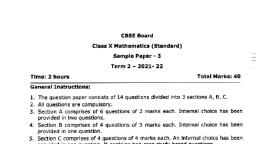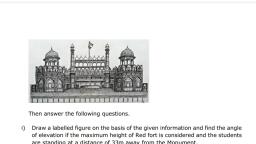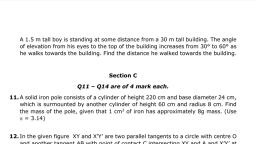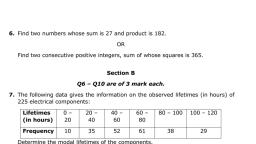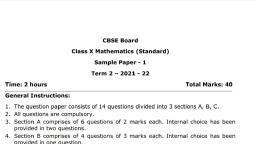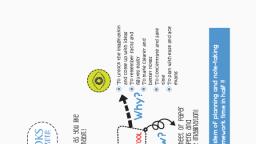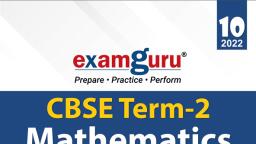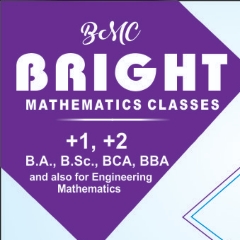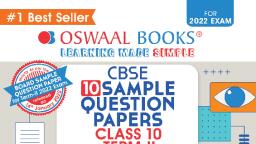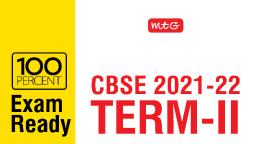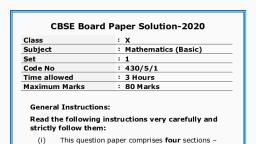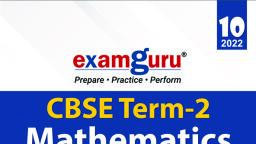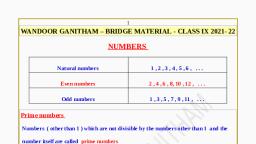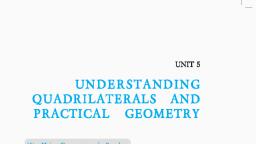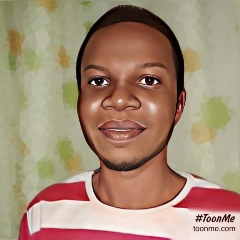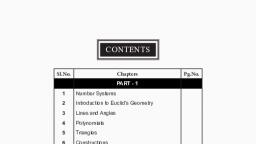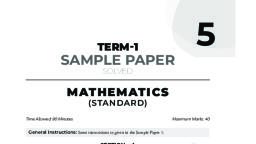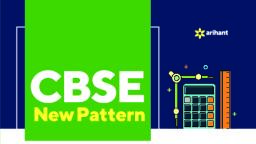Page 1 :
~>Want More Notes, Question Banks,, , Sample Papers?, , Kanaan
Page 2 :
To download all these materials in free of cost, just visit
Page 3 :
Sample Question Paper - 5, Mathematics-Standard (041), Class- X, Session: 2021-22, TERM II, , Time Allowed: 2 hours, , Maximum Marks: 40, , General Instructions:, 1. The question paper consists of 14 questions divided into 3 sections A, B, C., 2. All questions are compulsory., 3. Section A comprises of 6 questions of 2 marks each. Internal choice has been provided in two, questions., , ne, r, , 4. Section B comprises of 4questions of 3 marks each. Internal choice has been provided in one, question., , or, , 5. Section C comprises of 4 questions of 4 marks each. An internal choice has been provided in one, question. It contains two case study-based questions., , [2], , Find the 8th term from the end of the A.P. 7,10, 13, ..., 184., , oo, k, , 1., , C, , Section A, , OR, , eB, , Is the given series 2, 4, 8, 16, ...... form an AP? If It forms an AP, then find the common difference d, and write the next three terms., , Solve the quadratic equation by factorization:, 3x2 - 14x - 5 = 0, , In the given figure, common tangents AB and CD to the two circles with centres O1 and O2, , N, , 3., , [2], , ts, , 2., , [2], , @, , intersect at E. Prove that AB = CD., , 4., , A copper sphere of radius 3 cm is melted and recast into a right circular cone of height 3 cm., , [2], , Find the radius of the base of the cone., 5., , Write the frequency distribution table for the following data:, Marks(out of 90), , [2], , Number of candidates, , More than or equal to 80, , 4, , More than or equal to 70, , 6, , More than or equal to 60, , 11, , More than or equal to 50, , 17
Page 4 :
6., , More than or equal to 40, , 23, , More than or equal to 30, , 27, , More than or equal to 20, , 30, , More than or equal to 10, , 32, , More than or equal to 0, , 34, [2], , Find the roots of the quadratic equation 4x2 - 4px + (p2- q2) = 0., OR, , Find the roots of the quadratic equation given as: 2x2 + x – 4 = 0 by applying the quadratic formula., Section B, , 8., , Find the mean, median and mode of the following data:, , [3], , Class, , 0 - 20, , 20 - 40, , 40 - 60, , 60 - 80, , 80 - 100, , 100 - 120, , 120 - 140, , Frequency, , 6, , 8, , 10, , 12, , 6, , 5, , 3, , Construct a ΔABC in which AB = 5 cm. ∠B =, , ∘, , 60, , altitude CD = 3 cm. Construct a ΔAQR, , ne, r, , 7., , [3], , similar to ΔABC such that side of ΔAQR is 1.5 times that of the corresponding sides of, ΔACB., , 10., , 100 - 120, , 120 -140, , 140 - 160, , 160 - 180, , 180 - 200, , Frequency, , 10, , 20, , 30, , 15, , 5, , If a tower 30m high, casts a shadow, , –, 10 √3m, , eB, , elevation of the sun?, , C, , Class, , or, , Find the mean of the following frequency distribution, using the assumed-mean method:, , oo, k, , 9., , long on the ground, then what is the angle of, , [3], , [3], , OR, , A man rowing a boat away from a lighthouse 150 m high takes 2 minutes to change the angle of, –, , Section C, , An iron pillar has some part in the form of a right circular cylinder and remaining in the form [4], , @, , 11., , N, , ts, , elevation of the top of lighthouse from 45° to 30°. Find the speed of the boat. (Use √3 = 1.732), , of a right circular cone. The radius of base of each of cone and cylinder is 8 cm. The, cylindrical part is 240 cm high and the conical part is 36 cm high. Find the weight of the pillar,, if one cubic cm of iron weighs 10 g., 12., , In the adjoining figure, a circle inscribed in triangle ABC touches its sides AB, BC and AC at, , [4], , points D, E and F respectively. If AB = 12 cm, BC = 8 cm and AC = 10 cm, find the lengths of AD,, BE and CF., , OR, In the adjoining figure, a circle is inscribed in a quadrilateral ABCD in which ∠B = 90°. If AD = 23, cm, AB = 29 cm, and DS = 5 cm, find the radius (r) of the circle.
Page 5 :
13., , The houses of Ajay and Sooraj are at 100 m distance and the height of their houses is the same, , [4], , as approx 150m. One big tower was situated near their house. Once both friends decided to, measure the height of the tower. They measure the angle of elevation of the top of the tower, from the roof of their houses. The angle of elevation of ajay's house to the tower and sooraj's, house to the tower are 45o and 30o respectively as shown in the figure., , ne, r, , By using the above given information answer the following questions:, i. Find the height of the tower., , C, , Akshat's father is planning some construction work in his terrace area. He ordered 360 bricks, and instructed the supplier to keep the bricks in such as way that the bottom row has 30, , N, , ts, , eB, , oo, k, , bricks and next is one less than that and so on., , The supplier stacked these 360 bricks in the following manner, 30 bricks in the bottom row, 29, bricks in the next row, 28 bricks in the row next to it, and so on., , @, , 14., , or, , ii. What is the distance between the tower and the house of Sooraj?, , i. In how many rows, 360 bricks are placed?, ii. How many bricks are there in the top row?, , [4]
Page 6 :
Solution, MATHEMATICS STANDARD 041, Class 10 - Mathematics, Section A, 1. A.P. 7, 10, 13,....., 184, Last term (l) = 184, Common difference(d) = 10 - 7 = 3, 8th term from end, = l - (n - 1)d, = 184 - (8 - 1)× 3, = 184 - 21, = 163, , ∴, , OR, If ak+1 - ak is same for different values of k, then the series is in the form of an AP., here, we have a1 = 2, a2 = 4, a3 = 8 and a4 = 16, a4 - a3 = 16 - 8 = 8, , ne, r, , a3 - a2 = 8 - 4 = 4, a2 - a1 = 4 - 2 = 2, , Here, ak+1 - ak i.e. the common difference is not same for all values of k, , or, , Hence, the given series does not form an AP., 2. We have,, , C, , 3x2 - 14x - 5 = 0, , oo, k, , So, 3x2 - 14x - 5 = 0, 3x2 - 15x + 1x - 5 = 0, ⇒ 3x(x - 5) + 1(x - 5) = 0, ⇒ (x - 5)(3x + 1) = 0, ⇒ x - 5 = 0 or 3x + 1 = 0, ⇒, , x = 5 or x =, , −, , 1, 3, , eB, , ⇒, , 1, , . Hence the roots are 5 and − 3, , EB, , for the circle having centre O2, , @, , And, ED =, , N, , ts, , 3. We know that tangent segments to a circle from the same external point are congruent., So, EA = EC for the circle having centre O1, Now, Adding ED on both sides in EA, , = EC, , , we get, , EA + ED = EC + ED, , ⇒EA + EB = EC + ED, ⇒AB = C D, , 4. According to the question,we are given that,, Radius of sphere = 3 cm, Height of cone = 3 cm, Let, radius of cone = x cm, According to question, we have,, Volume of sphere = Volume of cone, ⇒, ⇒, ⇒, ⇒, , 4, 3, 4, 3, , 3, , πR, ×, , =, , 22, 7, , 1, 3, , 2, , πr h, , × 3× 3× 3 =, 2, , 4× 3× 3× 3 = x, , 1, 3, , ×, , 22, 7, , × 3, , 2, , 36 = x, −, −, x = √36, , 2, , × x, , = 6 cm, ⇒, Therefore, Radius of base of cone = 6 cm, 5. Frequency distribution table:, , × 3
Page 7 :
Marks, , Number of candidates, 0 -10, , 34-32=2, , 10 - 20, , 32-30=2, , 20 - 30, , 30-27=3, , 30 - 40, , 27-23=4, , 40 - 50, , 23-17=6, , 50 - 60, , 17-11=6, , 60 - 70, , 11-6=5, , 70 - 80, , 6-4=2, , more than 80, , 4, , 6. we have to find the roots of the quadratic equation 4x2 - 4px + (p2- q2) = 0., Here, a = 4, b = - 4p, c = (p2 - q2), The roots are given by the quadratic formula, 2, , x =, , −b±√b −4ac, 2a, 2, , 2, , x =, , 2, , ), , ne, r, , 4p±√16 p −4×4×(p −q, , ∴, , 2×4, 2, , 2, , 4p±√16 p −16 p +16 q, , =, , 2, , 8, , or, , 4p±4q, , =, , 8, p+q, 2, , ,, , p−q, 2, , ., , C, , Therefore, the roots are, , + bx + c, , we get, a = 2, b = 1, c = -4, , eB, , 2, , ax, , oo, k, , OR, We have given that 2x2 + x − 4 = 0, Comparing the given equation with standard form of quadratic equation, , 2, , The roots are given as, x =, [−1±√1−4(2)(−4)], , 7., , The roots are, , 4, , −1+√33, 4, , and, , @, , ∴, , =, , 2×2, , 2a, , −1±√33, , −1−√33, , N, , =, , −b±√b −4ac, , ts, , ∴, , 4, , Section B, , Class interval, , Mid value (x), , Frequency (f), , fx, , Cumulative frequency, , 0 - 20, , 10, , 6, , 60, , 6, , 20 - 40, , 30, , 8, , 240, , 17, , 40 - 60, , 50, , 10, , 500, , 24, , 60 - 80, , 70, , 12, , 840, , 36, , 80 - 100, , 90, , 6, , 540, , 42, , 100 - 120, , 110, , 5, , 550, , 47, , 120 - 140, , 130, , 3, , 390, , 50, , N = 50, Mean =, , Σf x, N, , =, , 3120, 50, , We have,, N = 50, Then,, , N, 2, , =, , 50, 2, , = 25, , = 62.4, , Σf x, , = 3120
Page 8 :
The cumulative frequency just greater than, , N, 2, , is 36, then the median class is 60 - 80 such that, , l = 60, h = 80 - 60 = 20, f = 12, F = 24, N, , Median = l +, = 60 +, , 25−24, , = 60 +, , 20, , 12, , −F, , 2, , ×, , f, , ×, , h, , 20, , 12, , = 60 + 1.67, = 61.67, Here the maximum frequency is 12, then the corresponding class 60 - 80 is the modal class, l = 60, h = 80 - 60 = 20, f = 12, f1 = 10, f2 = 6, Mode = l +, , f −f1, 2f −f −f, 1, , = 60 +, = 60 +, , 12−10, 2×12−10−6, , ×, , h, , 2, , ×, , 20, , 40, 8, , eB, , oo, k, , C, , or, , ne, r, , = 65, 8. Steps of construction:-, , @, , N, , ts, , i. Draw a line segment AB of length 5 cm., ∘, ii. Taking B as point construct an angle measure of 60 using a compass., iii. Name the angle as angle ABX., iv. Draw a line EF at a height of 3 cm such that it is parallel to the line segment AB. It must intersect ray BX at, point C. Now join AC., v. Draw CD perpendicular to AB. CD is the altitude of △ABC having height 3 cm, vi. △AQR is 1.5 times that of the corresponding sides of △ACB, i.e 3/2 times the corresponding sides of, △ACB., vii. Draw any ray AL making acute angle ∠BAL with AB., viii. Mark three points X1, X2, X3 on AL., ix. Join BX2, and draw line parallel to it passing from X3, intersecting AB extended at R., x. Draw line parallel to CB through R to intersect AC extended at Q., xi. △ARQ is the required triangle., 9. Let assumed mean (A) = 150., Marks, , Frequency(fi), , Mid value xi, , di = (xi - 150), , 100 - 120, , 10, , 110, , -40, , -400, , 120- 140, , 20, , 130, , -20, , -400, , 140 - 160, , 30, , 150 = A, , 0, , 0, , 160 - 180, , 15, , 170, , 20, , 300, , 180 - 200, , 5, , 190, , 40, , 200, , (fi, , × di, , )
Page 9 :
Σ fi = 80, , Σ (fi × di ) = −300, , we know that ,, mean=, , ∑(f ×di ), i, , A+, , ∑f, , i, , (−300), , = (150 +, , 80, , ), , = 150 − 3.75 = 146.25, , 10. Let AB be the pole and let AC be its shadow., , tan θ =, , AB, AC, , ⇒ θ = 60, , 30, , =, , 10 √3, , –, = √3, , ∘, , eB, , oo, k, , C, , or, , OR, , ne, r, , Let the angle of elevation of the sun be θ∘ ., ∘, Then, ∠AC B = θ, ∠C AB = 90 ., –, AB = 30m and AC = 10√3m., From right ΔC AB, we have, , ⇒, , = tan 45, 150, BC, , ∘, , N, , BC, , = 1 ⇒ BC = 150m, , In right △ABD,, ⇒, , 150, BD, , =, , 1, √3, , @, , AB, , ts, , AB = 150 m, Initially boat is at C and after 2 minutes it reaches at D., In right △ABC,, , AB, , BD, , = tan 30, , ∘, , –, ⇒ BD = 150√3, , Distance covered in 2 minutes=, ∴, , speed =, , Distance covered, time taken, , =, , BD − BC, , –, , = 150√3 − 150, , 150(√3−1), 2, , = 75 × (1.732 − 1), = 54.9 m/min, , Section C, , –, = 150(√3 − 1)m
Page 10 :
11., , 2, , = πr h +, = [, , 22, 7, , 1, 3, , 2, , 2, , πR H = πr, , × 8 × 8 × (240 +, , (h +, 1, 3, , 1, 3, , H), , [as r=R= 8cm each], , × 36)] cm, , 3, , = 50688 cm3, , = (, , 50688×10, 1000, , or, , Weight of the pilllar = volume in cm3 × weight per cm3, ) kg = 506.88kg, , C, , ∴, , ne, r, , Let us suppose that r denotes the radius of the cylinder = 8 cm., Suppose R denotes the radius of the cone = 8 cm., Let h be the height of the cylinder = 240cm., Suppose H is the height of the cone = 36 cm., Total volume of the iron = volume of the cylinder + volume of the cone, , @, , N, , ts, , eB, , oo, k, , Therefore, the weight of the pillar is 506.88 kg., 12. We know that tangents drawn from an external point to a circle are equal., ⇒ AD = AF, BD = BE, CE = CF., Let AD = AF = a, BD = BE = b, CE = CF = c, AB = AD + DB = a + b = 12 -------- (1), BC = BE + EC = b + c = 8 -------- (2), AC = AF + FC = a + b = 10 -------- (3), Adding (1), (2) and (3), we obtain, 2 (a + b + c) = 30, ⇒ (a + b + c) = 15 -------- (4), Subtracting (1) from (4), we get c = 3, Subtracting (2) from (4), we get a = 7, Subtracting (3) from (4), we get b = 5, Therefore, AD = a = 7 cm, BE = b = 5 cm and CE = 3 cm, OR, As we know that tangents drawn from an external point to a circle are equal,, we can write DR = DS = 5 cm, , Therefore, we have, AR = AD - DR = 23 - 5 = 18 cm, But, AR = AQ, therefore, AQ = 18 cm, and BQ = AB - AQ, = 29 - 18, = 11 cm, But, BP = BQ
Page 11 :
or, , ne, r, , Therefore, BP = 11 cm, Also, ∠Q = ∠P = 90° (as tangents are perpendicular to radius at point of contact), In quadrilateral OQBP,, ∠QOP + ∠P + ∠B + ∠OQB = 360°, ∠QOB = 360° - ( ∠P + ∠Q + ∠B ), = 360° - (90° + 90° + 90°) = 90°, Hence, the given quadrilateral OQBP is a rectangle as all angles are 90°., Now, it's opposite sides would also be equal so,, BQ = OP =11cm ( BP = BQ = 11cm), and OQ = BP =11 cm, ∴ BQ = OQ = OP = BP = 11 cm, As all sides are equal and all angles are of 90°, Thus BQOP is a square., Hence, the circle has the radius equal to 11 cm., 13. The above figure can be redrawn as shown below:, , PQ, QA, , oo, k, , tan 45 =, , C, , i. Let PQ = y, In ΔPQA,, y, , =, , x, , y, , 1=, , =, , =, , x, x+100, , 100, √3−1, , y, , =, , x+100, , =, , x, , x+100, , @, , –, x √3 = x + 100, x =, , PQ, x+100, , N, , 1, √3, , QB, , ts, , PQ, , tan 30 =, , eB, , x, , x = y .....(i), In ΔPQB,, , = 136.61 m, , From the figure, Height of tower h = PQ + QR, = x + 150 = 136.61 + 150 = 286.61 m, ii. Distance of Sooraj's house from tower = QA + AB, = x + 100 = 136.61 + 100 = 236.61 m, 14. Number of bricks in the bottom row=30. in the next row=29, and so on., therefore, Number of bricks stacked in each row form a sequence 30, 29, 28, 27,... , which is an AP with first, term , a=30 and common difference, d= 29 - 30 = -1., Suppose number of rows is n , then sum of number of bricks in n rows should be 360, i.e. Sn = 360, n, n, ⇒, [2 × 30 + (n − 1)(−1)] = 360 {Sn =, (2a + (n − 1)d) }, 2, 2, ⇒ 720 = n(60 − n + 1), 2, , ⇒ 720 = 60n - n, 2, , ⇒ n, , 2, , ⇒ n, , + n, , − 61n + 720 = 0, − 16n − 45n + 720 = 0, , [by factorisation], , ⇒ n(n − 16) − 45(n − 16) = 0, ⇒ (n − 16)(n − 45) = 0
Page 12 :
or (n − 45) = 0, or n = 45, Hence, number of rows is either 45 or 16., When, n = 16 ,, a16 = 30 + (16 − 1)(−1) {an = a + (n − 1)d }, ⇒ (n − 16) = 0, ⇒ n = 16, , = 30 − 15 = 15, , When, n, , = 45, , {an = a + (n − 1)d }, [∵ The number of logs cannot be neagtive], Hence, the number of rows is 16 and number of logs in the top row is 15., a45 = 30 + (45 − 1)(−1), , @, , N, , ts, , eB, , oo, k, , C, , or, , ne, r, , = 30 − 44 = −14
Page 13 :
CLICK ON IMAGE TO, JOIN US ON TELEGRAM, , CLICK HERE TO JOIN, US ON TELEGRAM

